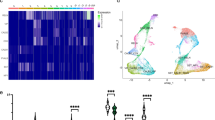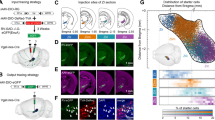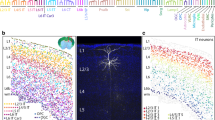Abstract
Autapses selectively form in specific cell types in many brain regions. Previous studies have also found putative autapses in principal spiny projection neurons (SPNs) in the striatum. However, it remains unclear whether these neurons indeed form physiologically functional autapses. We applied whole-cell recording in striatal slices and identified autaptic cells by the occurrence of prolonged asynchronous release (AR) of neurotransmitters after bursts of high-frequency action potentials (APs). Surprisingly, we found no autaptic AR in SPNs, even in the presence of Sr2+. However, robust autaptic AR was recorded in parvalbumin (PV)-expressing neurons. The autaptic responses were mediated by GABAA receptors and their strength was dependent on AP frequency and number. Further computer simulations suggest that autapses regulate spiking activity in PV cells by providing self-inhibition and thus shape network oscillations. Together, our results indicate that PV neurons, but not SPNs, form functional autapses, which may play important roles in striatal functions.







Similar content being viewed by others
Data Availability
All relevant data and computation codes are available from the corresponding authors upon request.
References
Burke DA, Rotstein HG, Alvarez VA. Striatal local circuitry: A new framework for lateral inhibition. Neuron 2017, 96: 267–284.
Vergara R, Rick C, Hernández-López S, Laville JA, Guzman JN, Galarraga E. Spontaneous voltage oscillations in striatal projection neurons in a rat corticostriatal slice. J Physiol 2003, 553: 169–182.
Miguelez C, Morera-Herreras T, Torrecilla M, Ruiz-Ortega JA, Ugedo L. Interaction between the 5-HT system and the basal Ganglia: Functional implication and therapeutic perspective in Parkinson’s disease. Front Neural Circuits 2014, 8: 21.
Diao Z, Di Y, Wu M, Zhai C, Kang M, Li Y, et al. Single exposure to cocaine impairs reinforcement learning by potentiating the activity of neurons in the direct striatal pathway in mice. Neurosci Bull 2021, 37: 1119–1134.
Ponzi A, Barton SJ, Bunner KD, Rangel-Barajas C, Zhang ES, Miller BR, et al. Striatal network modeling in Huntington’s Disease. PLoS Comput Biol 2020, 16: e1007648.
DiFiglia M, Pasik P, Pasik T. A Golgi study of neuronal types in the neostriatum of monkeys. Brain Res 1976, 114: 245–256.
Calabresi P, Picconi B, Tozzi A, Ghiglieri V, di Filippo M. Direct and indirect pathways of basal Ganglia: A critical reappraisal. Nat Neurosci 2014, 17: 1022–1030.
Silberberg G, Planert H. Optogenetic dissection of the striatal microcircuitry. Advanced Patch-Clamp Analysis for Neuroscientists. New York, NY: Springer New York, 2016: 151–170.
Blomeley CP, Bracci E. Serotonin excites fast-spiking interneurons in the striatum. Eur J Neurosci 2009, 29: 1604–1614.
Orduz D, Bischop DP, Schwaller B, Schiffmann SN, Gall D. Parvalbumin tunes spike-timing and efferent short-term plasticity in striatal fast spiking interneurons. J Physiol 2013, 591: 3215–3232.
Owen SF, Berke JD, Kreitzer AC. Fast-spiking interneurons supply feedforward control of bursting, calcium, and plasticity for efficient learning. Cell 2018, 172: 683-695.e15.
Johansson Y, Silberberg G. The functional organization of cortical and thalamic inputs onto five types of striatal neurons is determined by source and target cell identities. Cell Rep 2020, 30: 1178-1194.e3.
Mallet N, Ballion B, Le Moine C, Gonon F. Cortical inputs and GABA interneurons imbalance projection neurons in the striatum of parkinsonian rats. J Neurosci 2006, 26: 3875–3884.
Cepeda C, Galvan L, Holley SM, Rao SP, André VM, Botelho EP, et al. Multiple sources of striatal inhibition are differentially affected in Huntington’s disease mouse models. J Neurosci 2013, 33: 7393–7406.
Bekkers JM. Neurophysiology: Are autapses prodigal synapses? Curr Biol 1998, 8: R52–R55.
van der Loos H, Glaser EM. Autapses in neocortex cerebri: Synapses between a pyramidal cell’s axon and its own dendrites. Brain Res 1972, 48: 355–360.
Yin L, Zheng R, Ke W, He Q, Zhang Y, Li J, et al. Autapses enhance bursting and coincidence detection in neocortical pyramidal cells. Nat Commun 2018, 9: 4890.
Bacci A, Huguenard JR, Prince DA. Functional autaptic neurotransmission in fast-spiking interneurons: A novel form of feedback inhibition in the neocortex. J Neurosci 2003, 23: 859–866.
Li J, Deng S, He Q, Ke W, Shu Y. Asynchronous glutamate release at autapses regulates spike reliability and precision in mouse neocortical pyramidal cells. Cereb Cortex 2020, 31: 2278–2290.
Jiang M, Zhu J, Liu Y, Yang M, Tian C, Jiang S, et al. Enhancement of asynchronous release from fast-spiking interneuron in human and rat epileptic neocortex. PLoS Biol 2012, 10: e1001324.
Manseau F, Marinelli S, Méndez P, Schwaller B, Prince DA, Huguenard JR, et al. Desynchronization of neocortical networks by asynchronous release of GABA at autaptic and synaptic contacts from fast-spiking interneurons. PLoS Biol 2010, 8: e1000492.
Bekkers JM, Clements JD. Quantal amplitude and quantal variance of strontium-induced asynchronous EPSCs in rat dentate granule neurons. J Physiol 1999, 516(Pt 1): 227–248.
Shi WX, Rayport S. GABA synapses formed in vitro by local axon collaterals of nucleus accumbens neurons. J Neurosci 1994, 14: 4548–4560.
Park MR, Lighthall JW, Kitai ST. Recurrent inhibition in the rat neostriatum. Brain Res 1980, 194: 359–369.
Chartove JAK, McCarthy MM, Pittman-Polletta BR, Kopell NJ. A biophysical model of striatal microcircuits suggests gamma and beta oscillations interleaved at delta/theta frequencies mediate periodicity in motor control. PLoS Comput Biol 2020, 16: e1007300.
Wang T, Yin L, Zou X, Shu Y, Rasch MJ, Wu S. A phenomenological synapse model for asynchronous neurotransmitter release. Front Comput Neurosci 2016, 9: 153.
Volman V, Behrens MM, Sejnowski TJ. Downregulation of parvalbumin at cortical GABA synapses reduces network gamma oscillatory activity. J Neurosci 2011, 31: 18137–18148.
Wilson CJ, Groves PM. Fine structure and synaptic connections of the common spiny neuron of the rat neostriatum: A study employing intracellular inject of horseradish peroxidase. J Comp Neurol 1980, 194: 599–615.
McCarthy MM, Moore-Kochlacs C, Gu X, Boyden ES, Han X, Kopell N. Striatal origin of the pathologic beta oscillations in Parkinson’s disease. Proc Natl Acad Sci U S A 2011, 108: 11620–11625.
Venance L, Glowinski J. Heterogeneity of spike frequency adaptation among medium spiny neurones from the rat striatum. Neuroscience 2003, 122: 77–92.
Cepeda C, André VM, Yamazaki I, Wu N, Kleiman-Weiner M, Levine MS. Differential electrophysiological properties of dopamine D1 and D2 receptor-containing striatal medium-sized spiny neurons. Eur J Neurosci 2008, 27: 671–682.
Kawaguchi Y. Physiological, morphological, and histochemical characterization of three classes of interneurons in rat neostriatum. J Neurosci 1993, 13: 4908–4923.
Deng S, Li J, He Q, Zhang X, Zhu J, Li L, et al. Regulation of recurrent inhibition by asynchronous glutamate release in neocortex. Neuron 2020, 105: 522-533.e4.
Hefft S, Jonas P. Asynchronous GABA release generates long-lasting inhibition at a hippocampal interneuron–principal neuron synapse. Nat Neurosci 2005, 8: 1319–1328.
Sciamanna G, Wilson CJ. The ionic mechanism of gamma resonance in rat striatal fast-spiking neurons. J Neurophysiol 2011, 106: 2936–2949.
Chen H, Lei H, Xu Q. Neuronal activity pattern defects in the striatum in awake mouse model of Parkinson’s disease. Behav Brain Res 2018, 341: 135–145.
Hu H, Gan J, Jonas P. Interneurons. Fast-spiking, parvalbumin+ GABAergic interneurons: From cellular design to microcircuit function. Science 2014, 345: 1255263.
Nahar L, Delacroix BM, Nam HW. The role of parvalbumin interneurons in neurotransmitter balance and neurological disease. Front Psychiatry 2021, 12: 679960.
Kerchner GA, Nicoll RA. Silent synapses and the emergence of a postsynaptic mechanism for LTP. Nat Rev Neurosci 2008, 9: 813–825.
Herrmann CS, Klaus A. Autapse turns neuron into oscillator. Int J Bifurcat Chaos 2004, 14: 623–633.
Bacci A, Huguenard JR. Enhancement of spike-timing precision by autaptic transmission in neocortical inhibitory interneurons. Neuron 2006, 49: 119–130.
Deleuze C, Bhumbra GS, Pazienti A, Lourenço J, Mailhes C, Aguirre A, et al. Strong preference for autaptic self-connectivity of neocortical PV interneurons facilitates their tuning to γ-oscillations. PLoS Biol 2019, 17: e3000419.
Gui DY, Yu T, Hu Z, Yan J, Li X. Dissociable functional activities of cortical theta and beta oscillations in the lateral prefrontal cortex during intertemporal choice. Sci Rep 2018, 8: 11233.
Petersen PC, Buzsáki G. Cooling of medial septum reveals Theta phase lag coordination of hippocampal cell assemblies. Neuron 2020, 107: 731-744.e3.
Masimore B, Schmitzer-Torbert NC, Kakalios J, Redish AD. Transient striatal gamma local field potentials signal movement initiation in rats. Neuroreport 2005, 16: 2021–2024.
Berke JD. Fast oscillations in cortical-striatal networks switch frequency following rewarding events and stimulant drugs. Eur J Neurosci 2009, 30: 848–859.
Berke JD, Okatan M, Skurski J, Eichenbaum HB. Oscillatory entrainment of striatal neurons in freely moving rats. Neuron 2004, 43: 883–896.
Acknowledgements
We are grateful to Drs. Suixin Deng and Junlong Li for their help in data analysis. This work was supported by the National Natural Science Foundation of China (32130044, 31630029, 32171094, and 32100930) and the National Key Research and Development Program of China (2021ZD0202500).
Author information
Authors and Affiliations
Corresponding authors
Ethics declarations
Conflict of interest
The authors claim that there are no conflicts of interest.
Supplementary Information
Below is the link to the electronic supplementary material.
Rights and permissions
Springer Nature or its licensor (e.g. a society or other partner) holds exclusive rights to this article under a publishing agreement with the author(s) or other rightsholder(s); author self-archiving of the accepted manuscript version of this article is solely governed by the terms of such publishing agreement and applicable law.
About this article
Cite this article
Wang, X., Shu, Z., He, Q. et al. Functional Autapses Form in Striatal Parvalbumin Interneurons but not Medium Spiny Projection Neurons. Neurosci. Bull. 39, 576–588 (2023). https://doi.org/10.1007/s12264-022-00991-x
Received:
Accepted:
Published:
Issue Date:
DOI: https://doi.org/10.1007/s12264-022-00991-x




